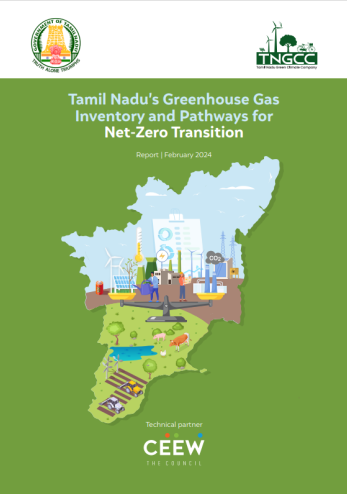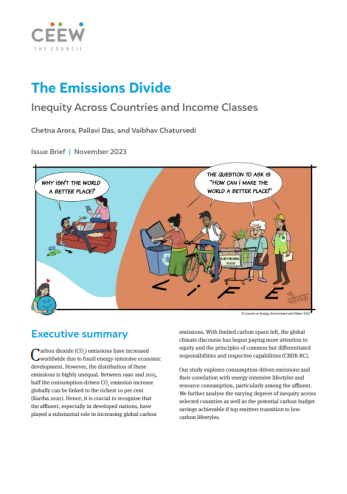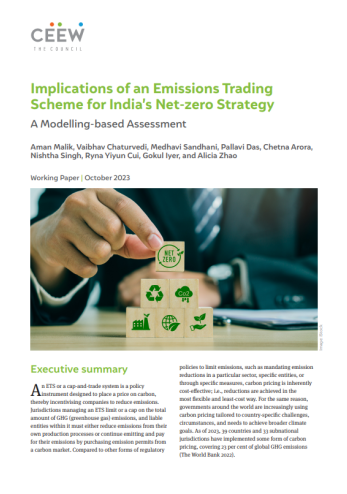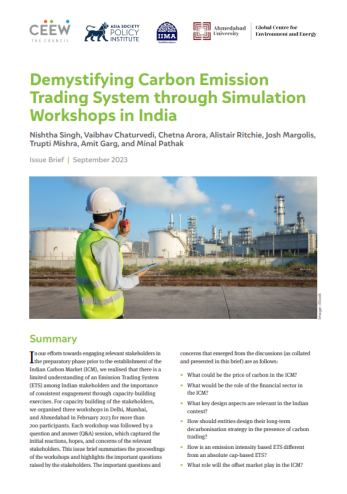



Suggested citation: Singh, Nishtha and Vaibhav Chaturvedi. 2023. Understanding Carbon Markets: Prospects for India and Stakeholder Perspectives. New Delhi: Council on Energy, Environment and Water.
The Government of India has passed an amendment to the Energy Conservation Act 2001, which lays the foundation for the Indian Carbon Market. Under this backdrop, CEEW conducted an industry stakeholder discussion to understand their concerns and perspectives. This issue brief deconstructs the two key typologies of carbon markets – project-based/offset and Emission Trading Scheme (ETS) based-market and outlines their key features that determine their environmental integrity and functional boundaries. It further outlines the Indian policy landscape in the context of market-based instruments and recent developments towards the formation of an Indian Carbon Market. Finally, the brief discusses the primary concerns of key Indian stakeholders with the announcement of the Indian carbon market and presents its recommendation.
The Government of India’s announcement regarding the creation of a carbon credits market is a path- breaking one. This follows numerous other actions like the net-zero announcement that demonstrate India’s leadership in and ambition for climate change mitigation. Against this backdrop, our issue brief discusses alternative forms of carbon markets and assesses the perspective of Indian stakeholders on this subject. We highlight and explain the two alternative approaches of carbon markets: ‘offset market (project-based)’ and ‘cap-and-trade (or emissions trading scheme [ETS])’. The two approaches are significantly different from each other in terms of the key characteristics that define their structure, as well as quality, environmental integrity, and operational boundary of tradeable units. In this context, we conducted an industry stakeholder discussion to understand their perspectives on the recent developments.
The key takeaways from the stakeholder discussion are:
Our overall recommendation is that India should align the early phase of the transition process as proposed by the Bureau of Energy Efficiency (BEE) with the development of an ETS that is similar to various other ETS systems prevalent in Asia and around the world, like the EU-ETS and the Korean ETS. Additionally, while learning from the experiences of other ETS systems around the world, the Indian ETS should be designed to reflect its national circumstances and economic structure.
To realise market-based instruments’ full potential and maintain their integrity and quality, it is important to understand their inherent characteristics and environmental boundaries.
The Government of India has passed an amendment to the Energy Conservation Act, 2001, which leads to establishment of a carbon credit market in India (The Energy Conservation (Amendment) Bill, 2022).
The amendment provides a legal framework for a carbon market with the objective of incentivising actions for emission reduction. Under the Indian carbon credit market, entities can register themselves as “Registered Entities” for the carbon credit trading scheme. The carbon credit certificate will be issued by the central government or any agency authorised by it. Any other person or entity may also purchase ESCerts or carbon credit certificates on a voluntary basis. Details of the operational nitty gritty and technical details of the carbon markets are yet to be outlined by the BEE. This brief outlines the different types of carbon markets, other market-based instruments in India unrelated to carbon dioxide emissions, and stakeholder concerns around the announcement of the Indian carbon credit market.
Section 2 introduces alternative forms of carbon markets and their key characteristics. Section 3 is a brief history of carbon markets under the United Nations. Section 4 describes the existing emission mitigation market-based instruments in India and the details of the carbon credit market in the proposed amendment to the Energy Conservation Act, 2001. Section 5 outlines the key takeaways from a stakeholder consultation meeting with industry representatives at CEEW and the proposed recommendations. Section 6 is our recommendation for the way forward.
CEEW curated a discussion with industry stakeholders on the implications of India’s domestic carbon markets for the voluntary carbon market, international carbon market and alternative market-based instruments in India. This section outlines the key insights from the discussion:
As highlighted in Section 2, broadly speaking, there are two alternative approaches to markets—one is offsets (project-based), and the other is ETS. The BEE white paper and policy paper envisages an eventual evolution of the PAT scheme into an ETS. Indian stakeholders across the private sector and civil society have an extensive experience in the project-based approach, be it through the compliance market (CDM) or the voluntary market. On the other hand, there is negligible knowledge and understanding of how the ETS system works in practice. This has important implications as market participants view any announcement related to carbon markets through the ‘offsets’ approach rather than an ETS approach.
A follow-up to the point highlighted above is that there needs to be a sustained engagement between the government, private sector and civil society on issues related to theoretical and operational aspects of an ETS for them to be better prepared and have a nuanced understanding of various issues related to an ETS. It is in everyone’s interest to ensure that the design of ETS is aligned with the realities of the country and that it incorporates learning from various forms of ETS systems being implemented in Asia and across the world. A deeper knowledge of this system is imperative for Indian stakeholders to look and think beyond the offset approach that they are most familiar with.
In the global carbon debate, carbon credits are given different names: certified emission reduction (CER) in the CDM market, emission reduction unit (ERU) in the JI market, allowance in the EU-ETS, and so on. As Indian stakeholders have experience related to the offset market approach, carbon credits is the term most commonly used in India and is used to define emission reduction or removal units of various forms. However, in the latest communication, the BEE has outlined three different types of carbon credit certificates: C-CCC, M-CCC and O-CCC. Additionally, there are still provisions in the document that some credits will be only traded domestically, some credits will be traded internationally, and they will have to undergo scrutiny through different methodologies with no specific taxonomy. It would be useful to clearly define and name different kinds of credits in the Indian market so that communication between various stakeholders is clear. A taxonomy of emission mitigation units in compliance and voluntary markets within India would be very useful for domestic stakeholders.
Indian stakeholders across the private sector and civil society have an extensive experience in the project- based approach, be it through the compliance market (CDM) or the voluntary market.
The amendment to the Energy Conservation Act, 2001 and the policy paper proposes to create a ‘voluntary’ carbon credit market where carbon credits will be issued by an agency authorised by the government and will be sold to voluntary buyers, including organisations and individuals. Voluntary buyers can also buy ESCerts in the market. This has created some confusion among market participants, as there already exists a thriving voluntary market, that is truly voluntary in the sense that there is no government intervention in this market, and the demand, supply, and verification of these credits are all undertaken in the private sector. Introducing the term ‘voluntary’ in a scheme that will be administered by the government is understandable and sensible as market participants should not be forced in the initial stages before they understand how the market will function in practice. The government, however, should clarify that there is no linkage of the government-administered ‘voluntary’ market with the existing voluntary market driven by the private sector.
Among the biggest challenges of the existing PAT scheme and the REC scheme are the shortage of demand for ESCerts and RECs in the market. Oversupply has led to a crash in the prices of RECs and ESCerts. The proposed carbon credit market aims at creating a demand for ESCerts and RECs, which is laudable. It is expected that in due course, the rules governing the fungibility of ESCerts and RECs to carbon credits will be finalised, and conversion will begin a post that. This approach, however, does not necessarily mean new and additional carbon emissions reduction. The last phase of the proposed market which will be an ETS, would not be an organic evolution from the initial phase mainly due to the fungibility issue. Providing value to companies with an unsold inventory of ESCerts and RECs is critical, but involving these in a carbon market could be complex and create confusion as far as the long-term ETS market design is concerned. It would be useful to explore alternative ways to address this. For example, when the government introduces auctioning, it could use some of the revenue proceeds to settle unsold CERs and ESCerts. This would allow for a simpler design for ETS from the beginning itself. Furthermore, an ETS design using benchmark-based allocation would reward the best performers under the PAT scheme that have surplus unsold ESCerts as they would get a greater share of free allowances in an ETS compared to their actual emissions, and would benefit financially by having less need to buy allowances and greater potential to sell.
Providing value to companies with an unsold inventory of ESCerts and RECs is critical, but involving these in a carbon market could be complex and create confusion as far as the long-term ETS market design is concerned.
India has historically been the seller of carbon credits through the CDM route. Along with this channel, the private sector-driven voluntary carbon market has also been a driver of climate finance in India. The voluntary suppliers of credits have received finance from both international companies as well as Indian companies. Ultimately, all these are offset systems. The ETS approach is fundamentally different, as the focus is on the end goal of cost-effective domestic GHG mitigation. Participants in the ETS system are trading among themselves to achieve a collective emissions cap in a cost-effective manner. Money for purchasing credits is hence flowing from one participant in the domestic ETS to the other. The only way to ensure that there is a flow of foreign money to fund India’s mitigation actions is if India’s ETS is linked (as a seller) to global ETSs like the EU-ETS. In the absence of that, only the UNFCCC- based (e.g., Article 6-related carbon markets) or the voluntary actions-driven markets would be a source of international climate finance for Indian companies. Notwithstanding this, an important aspect of an ETS is that it can provide an opportunity to generate a significant amount of domestic finance from auction revenue which can play a key role in financing the net- zero transition for the energy-intensive industry and power sectors, similar to the experience in the EU, while also protecting vulnerable stakeholder groups from increases in energy prices.
The UNFCCC-based market would stay in some form or the other. Also, it is important for the private sector- driven voluntary market to stay so that more ambitious actions (beyond what is necessary due to regulation) in the private sector can be driven through this market. Both these would be sources of finance for companies through offset (project-based) related investments. In addition to these, an ETS will serve as a key instrument for achieving country-level decarbonisation targets. All these three alternative forms of the market have the potential to deliver international finance as well as achieve India’s domestic mitigation targets. It is important to understand how a balance should be created between these three alternative market designs to flourish in India.
The announcement of the setting up of a carbon credit trading scheme by the Government of India is a path- breaking one. Based on stakeholder discussions, the key recommendation our assessment makes is that India should align the initial phase of the transition process with the development of an ETS similar to various other ETSs prevalent in Asia and around the world like the EU-ETS and Korean ETS. The Indian government should not intervene in the voluntary offset carbon market and let it function efficiently and independently. However, India’s compliance market, i.e., the ETS should reflect its national circumstances and economic structure while learning from the experiences of other ETS systems around the world. Indian stakeholders should view the domestic ETS as an instrument for decarbonisation and domestic climate finance rather than international climate finance. Ideally, the process for setting up the same should be a clean and simple process and avoid the pitfalls of fungibility-related issues that could confuse market participants. There should be enough time given to market participants and regulators to understand the operational nature of the ETS through a pilot phase. To achieve success, it is imperative that we start by clarifying all necessary concepts and bring all the stakeholders to par with an evolved understanding of alternative forms of the market, which is also the motivation behind this issue brief.
Carbon markets are markets where a tonne of carbon dioxide equivalent (CO2e) is commodified as a tradeable unit either as an emission allowance issued in an ETS system or as a verified emission reduction/removal credit (offset) issued in an offset (project-based) system. Carbon markets are intended to bring a price signal to GHG emissions leading to emission reduction. The purpose of carbon markets is to incentivise companies to reduce their carbon emissions and impose penalties on those exceeding emission limits, thereby bringing a price signal to GHG emissions and driving emission reduction efforts.
There are broadly two forms of carbon markets- offset and Emission Trading System. Offset-based market Offsets are produced through the project-based mechanism. If a project results in GHG emission reduction or removal, the project developer can claim carbon credits with one credit claimed per tonne of CO2e emissions reduced/ removed. The project developer can then sell these credits to individuals, organisations, or jurisdictions planning to offset their emissions. Additionally, UN –based markets exist in the form of CDM and JI under the Kyoto protocol and Article 6 market under the Paris Agreement. An ETS is a quantity-based tool in which regulated companies are limited to a certain amount of GHG emissions. This limit is called a "cap." Emission permits are given to and shared among groups, through bids. An ETS facilitates cost-effective emission mitigation amongst obligated entities. E.g. - EU ETS, K-ETS
India has a functional offset market in the form of CDM market and voluntary carbon market, The Indian experience is entirely about the project-based/ offset approach. Additionally, India also has an experience in implementing market-based instruments in the form of Perform Achieve and Trade (PAT) scheme to enhance energy efficiency and Renewable Purchase Obligation (RPO) to promote the uptake of renewable energy.
Until now, the carbon markets in India were anchored by UNFCCC for the CDM market and by private players for the voluntary carbon market. However, the government of India passed the amendment to Energy Conservation Act, 2001, which lays the foundation of Indian Carbon Market (ICM). The ICM will comprise a compliance and voluntary market and will be regulated by the government.

Tamil Nadu’s Greenhouse Gas Inventory and Pathways for Net-Zero Transition

The Emissions Divide: Inequity Across Countries and Income Classes

Implications of an Emissions Trading Scheme for India’s Net-zero Strategy

Demystifying Carbon Emission Trading System through Simulation Workshops in India